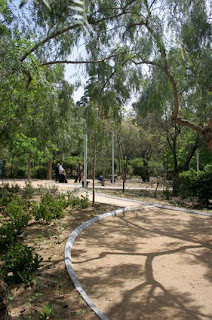FINAL STAGE: MONTEROLS GARDENS
Ver mapa más grande
Ver mapa más grande
Estimated time from Tamarita to Monterols Park: 14 minutes
Is a green space on a slope that rises to 121 m. The sharp drop of land determines its course and gives a great personality, and has created a corner surrounded by lush vegetation which is quite comfortable.
Several dirt roads lead us to the top of the hill, where we can enjoy great views over Barcelona. The route is circular and communicates the different areas of the park. On both sides of the roads, large trees and significant shrub masses isolate this green space from the buildings which surround it. Therefore, the first thing you hear when entering is the birdsong, feeling of being away from the city.
Everywhere there are rest areas with benches and shadow. The main park has a recreational area for dogs, very shady.
(Vegetation)
The trees are one of the main values of the park, which are essentially what there was originally in the field. We find cypress and oaks, one of which was planted in the early twentieth century and is in the Catalogue of interesting trees of Barcelona. There are also huge carob trees, olive trees and a few almonds, the vestige of the agricultural history of Sant Gervasi, and shrubs.
The small depression that remains of what was once a quarry has been landscaped with native vegetation. Here, we find two Washingtonia palms very tall.
(Art & Architecture)
At the entrance from Gualbes Street, a stone fountain decorated with a relief of cherubs holding garlands of flowers and fruits, made by an unknown author stands.
History
The Turó de Monterols, also called Turo d’en Gil in the early last century by reference to a former owner, is one of the spaces designed by Nicolau M. Rubio i Tudurí. This hill was part of a former private estate with garden and forest. Monterols Park opened on July 8, 1947, and the author of the remodeling project was the architect and director of Parks and Gardens, Lluís Riudor i Carol.



